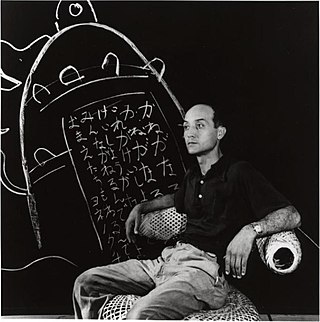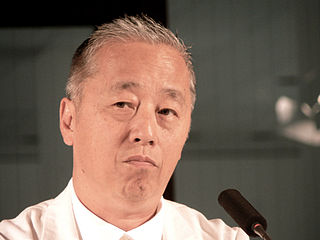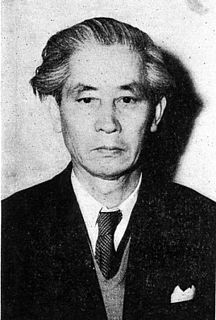
Kyoto, officially Kyoto City, is the capital city of Kyoto Prefecture in Japan. Located in the Kansai region on the island of Honshu, Kyoto forms a part of the Keihanshin metropolitan area along with Osaka and Kobe. As of 2021, the city has a population of 1.45 million, making up 57% of the prefecture's total population. The city is the cultural anchor of a substantially larger metropolitan area known as Greater Kyoto, a metropolitan statistical area (MSA) home to a census-estimated 3.8 million people in 2020 and ranking as the second MSA in the Kansai region.

Isamu Noguchi was a Japanese-American artist and landscape architect whose artistic career spanned six decades, from the 1920s onward. Known for his sculpture and public artworks, Noguchi also designed stage sets for various Martha Graham productions, and several mass-produced lamps and furniture pieces, some of which are still manufactured and sold.

Japanese architecture has been typified by wooden structures, elevated slightly off the ground, with tiled or thatched roofs. Sliding doors (fusuma) and other traditional partitions were used in place of walls, allowing the internal configuration of a space to be customized for different occasions. People usually sat on cushions or otherwise on the floor, traditionally; chairs and high tables were not widely used until the 20th century. Since the 19th century, however, Japan has incorporated much of Western, modern, and post-modern architecture into construction and design, and is today a leader in cutting-edge architectural design and technology.

Yayoi Kusama is a Japanese contemporary artist who works primarily in sculpture and installation, but is also active in painting, performance, video art, fashion, poetry, fiction, and other arts. Her work is based in conceptual art and shows some attributes of feminism, minimalism, surrealism, Art Brut, pop art, and abstract expressionism, and is infused with autobiographical, psychological, and sexual content. She has been acknowledged as one of the most important living artists to come out of Japan.

The Japanese dry garden or Japanese rock garden, often called a zen garden, is a distinctive style of Japanese garden. It creates a miniature stylized landscape through carefully composed arrangements of rocks, water features, moss, pruned trees and bushes, and uses gravel or sand that is raked to represent ripples in water. A zen garden is usually relatively small, surrounded by a wall or buildings, and is usually meant to be seen while seated from a single viewpoint outside the garden, such as the porch of the hojo, the residence of the chief monk of the temple or monastery. Many, with gravel rather than grass, are only stepped into for maintenance. Classical zen gardens were created at temples of Zen Buddhism in Kyoto during the Muromachi period. They were intended to imitate the essence of nature, not its actual appearance, and to serve as an aid to meditation about the true meaning of existence.

Japanese gardens are traditional gardens whose designs are accompanied by Japanese aesthetics and philosophical ideas, avoid artificial ornamentation, and highlight the natural landscape. Plants and worn, aged materials are generally used by Japanese garden designers to suggest a natural landscape, and to express the fragility of existence as well as time's unstoppable advance. Ancient Japanese art inspired past garden designers. Water is an important feature of many gardens, as are rocks and often gravel. Despite there being many attractive Japanese flowering plants, herbacious flowers generally play much less of a role in Japanese gardens than in the West, though seasonally flowering shrubs and trees are important, all the more dramatic because of the contrast with the usual predominant green. Evergreen plants are "the bones of the garden" in Japan. Though a natural-seeming appearance is the aim, Japanese gardeners often shape their plants, including trees, with great rigour.

Memoirs of a Geisha is a historical fiction novel by American author Arthur Golden, published in 1997. The novel, told in first person perspective, tells the story of a fictional geisha working in Kyoto, Japan, before, during and after World War II, and ends with her being relocated to New York City.

Hiroshi Sugimoto is a Japanese photographer and architect. He leads the Tokyo-based architectural firm New Material Research Laboratory.

Diarmuid Gavin is an Irish garden designer and television personality. He has presented gardens at the Chelsea Flower Show on nine occasions from 1995 to 2016, winning a number of medals, including gold in 2011. He has also authored or co-authored at least ten gardening-related books.

The Herbert F. Johnson Museum of Art is an art museum located on the northwest corner of the Arts Quad on the main campus of Cornell University in Ithaca, New York. Its collection includes two windows from Frank Lloyd Wright's Darwin D. Martin House, and more than 35,000 other works in the permanent collection. It was designed by architect I.M. Pei and is known for its distinctive concrete facade.

Jōchō, also known as Jōchō Busshi, was a Japanese sculptor of the Heian period. He popularized the yosegi technique of sculpting a single figure out of many pieces of wood, and he redefined the canon of body proportions used to create Buddhist imagery. His style spread across Japan and defined Japanese sculpture for the next 150 years. Today, art historians cite Jōchō as "the first of a new kind of master sculptor" and "one of the most innovative artists Japan has ever produced."

Borrowed scenery is the principle of "incorporating background landscape into the composition of a garden" found in traditional East Asian garden design. The term borrowing of scenery ("shakkei") is Chinese in origin, and appears in the 17th century garden treatise Yuanye.
Ikko Tanaka was a Japanese graphic designer.

Kyoto City University of Arts is a public, municipal university of general art and music in Kyoto, Japan. Established in 1880, it is Japan's oldest university of the arts. Among its faculty and graduates have been 16 recipients of the Order of Culture, 24 members of the Japan Art Academy, and 10 artists who have been designated Living National Treasures. It has been associated especially closely with nihonga painters from western Japan.
Donald Peter Greenberg is the Jacob Gould Schurman Professor of Computer Graphics at Cornell University.
Mirei Shigemori, was a Japanese landscape architect and historian of Japanese gardens.

Tōgo Murano was a Japanese architect. Although his formative years were between 1910 and 1930, he remained active in design throughout his life and at the time of his death was responsible for over three hundred completed projects.

Shoji Sadao was a Japanese American architect, best known for his work and collaborations with R. Buckminster Fuller and Isamu Noguchi. During World War II he was stationed in Germany and was a cartographer for the U.S. Army.

Namikawa Yasuyuki (1845–1927) — original family name Takaoka — was a Japanese cloisonné artist. His work was highly sought after in his own lifetime and is held in several collections today. He and Namikawa Sōsuke were the most famous cloisonné artists of the 1890 to 1910 period, known as the "Golden age" of Japanese enamels. From 1875 to 1915, he won prizes at 51 exhibitions, including at world's fairs and at Japan's National Industrial Exhibition. For his work he was appointed an Imperial Household Artist in 1896. He sometimes signed his pieces Kyoto Namikawa.

A tsubo-niwa (坪庭/壷庭/つぼにわ) is a type of very small garden in Japan. The term "tsuboniwa" stems from tsubo (坪), a unit of measurement, and "niwa", meaning "garden". Other spellings of tsubo-niwa translate to "container garden", and a tsubo-niwa may differ in size from the tsubo unit of measurement.
















